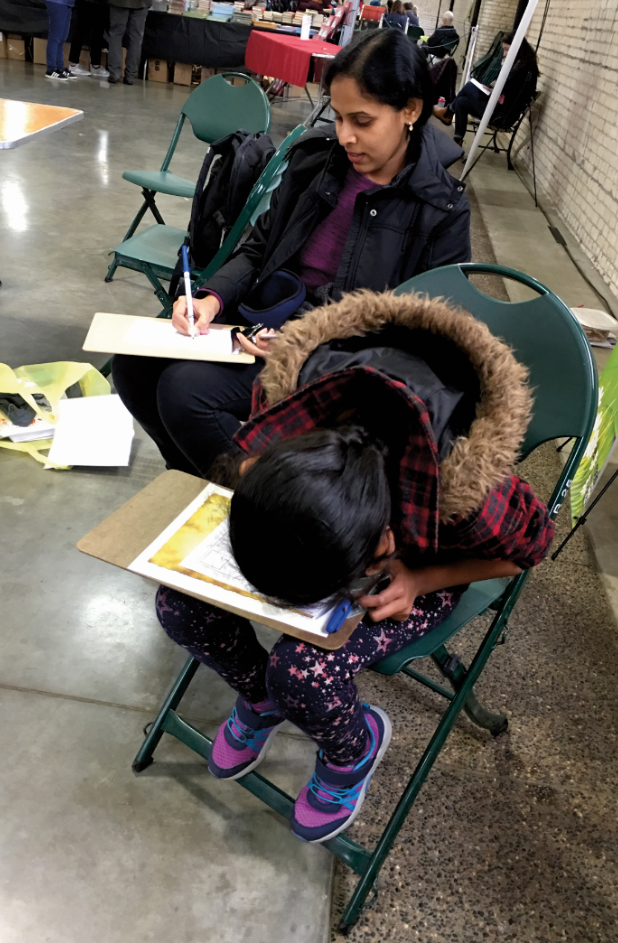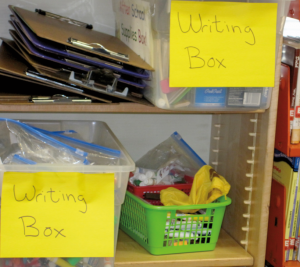3 Parents & Other Partners
Parents are children’s first teachers. One study found that parents teaching their children the alphabet, reading words to them, and printing words for them predicted kindergarten alphabet knowledge and Grade 3 reading fluency. Shared storybook reading predicted kindergarten vocabulary and the frequency with which children reported reading for pleasure in Grade 4.[1]
Parents don’t need to be told that reading aloud to children is a good practice for cognitive development. In his study of parents reading aloud, Dominic Massaro concluded that the vocabulary and language in picture books are more linguistically and cognitively enriching than everyday speech.[2] Most parents are advised to read to their children. Children who are read to and read with are more likely to select reading as a choice for recreation.

Librarians already partner with parents, caregivers, and Head Start program teachers by providing and modeling actions that impact the frequency and quality of interactions between adults and young children. We read, sing songs, recite nursery rhymes, and play finger games, all to model behavior that will support children’s success in learning.
If we accept the premise that reading in the home by parents and caregivers is a positive influence that predicts the acquisition of literacy, we can also encourage these adults to write in the home with their children as well. Sharon Edwards and Robert Maloy’s Kids Have All the Write Stuff: Inspiring Your Children to Put Pencil to Paper encourages parents to create a successful literacy learning environment.
Edwards and Maloy observed parents and their children writing over a four-year period, then developed a formula for successful children’s learning:
Play + Choice + Approximation + Risk-Taking = Children’s Learning
Play
The Writing Box program supports playful writing. Writing is not “work.” There is no “right way” to write.
Choice
We give parents and children a choice of prompts and materials. We know that competent writing, like reading, takes practice.
Approximation
This means accepting good tries at spelling and sentence structure, and even at different ways of communicating meaning, without constantly criticizing or correcting.
Risk-Taking
We ask all participants to take a risk, to be willing to try something new: “I have never made a map before!” Librarians can model enthusiasm in the face of a fear of failure, and help parents overcome the instinct for perfectionism: “Let’s get the writing down on the page. We can look up how to spell when we revise later.”
As librarians, we can use this formula to facilitate children’s writing and guide parent/caregiver interactions. We can share our knowledge of literature and early childhood learning in the Every Child Ready to Read® @ your library® (ECRR) programs (everychildreadytoread.org). We can encourage caregivers, babysitters, and parents to engage in writing with their children during and after Writing Box workshops.
The Writing Box program provides an opportunity to honor the cultural and socioeconomic diversity of our communities, and allows us to select materials to share that speak to our populations. In my St. Paul community, for example, many families grow thriving gardens. Some products of these efforts are for family tables, while others are destined for sale at the local farmers’ market. As we select books for our own Writing Box program, it is a delight to support independent publishers like Readers to Eaters, whose mission is to create books that offer, through authentic story and delightful writing, a fresh perspective on what and how we eat. A read aloud of the mentor text Farmer Will Allen and the Growing Table by Jacqueline Briggs Martin can, for example, generate a variety of writing prompts:
-
- If you farmed Will’s table, what would you grow?
- Describe your ideal farm.
- Draw a map of your neighborhood. Where is the garden? Create a plan for the garden.
- Do you have a recipe for any of the food that Will grows?
- Here is the map of my garden plan. What else could I plant?
As we encourage adults to participate, we support their voices, creating an opportunity for a successful literacy experience for them as well as their children.
Public Access
It is essential that the library provides public access hours to Writing Boxes and program materials. Writing Boxes that can be checked out from the reference or circulation desk are an essential component of a successful program.

Create a folder or file with writing prompts and writing samples that can be referred to during writing times. Provide materials for an array of writing activities for “out-of-workshop time.” Reproduce and have available cartoon frames, poetry prompts, map outlines, and hieroglyphic keys.
Resources
Clay, Marie. 1987. Writing Begins at Home: Preparing Children for Writing before They Go to School: ERIC.
Eamer, Claire, and Sa Boothroyd. 2012. The World in Your Lunch Box: the Wacky History and Weird Science of Everyday Foods. Toronto: Annick Press.
Martin, Jacqueline Briggs, Eric-Shabazz Larkin, and Will Allen. 2013. Farmer Will Allen and the Growing Table. Bellevue, Washington: Readers To Eaters.
Massaro, Dominic W. 2015. “Two Different Communication Genres and Implications for Vocabulary Development and Learning to Read.” Journal of Literacy Research 47 (4):505-527.
Mendez, Sean. 2011. One World Kids Cookbook: Easy, Healthy, and Affordable Family Meals. Interlink Pub Group.
Mo, Ya, Rachel A Kopke, Lisa K Hawkins, Gary A Troia, and Natalie G Olinghouse. 2014. “The Neglected “R” in a Time of Common Core.” The Reading Teacher 67 (6):445-453.
Morrison, Timothy G., Gregory Bryan, and George W. Chilcoat. 2002. “Using Student-Generated Comic Books in the Classroom.” Journal of Adolescent & Adult Literacy 45 (8):758-67.
Page, Stefan. 2014. We’re Going to the Farmers’ Market. San Francisco, CA: Chronicle Books LLC.
Sayre, April Pulley. 2013. Let’s Go Nuts! Seeds We Eat. First edition. ed. New York: Beach Lane Books.
Sénéchal, Monique, and Laura Young. 2008. “The Effect of Family Literacy Interventions on Children’s Acquisition of Reading from Kindergarten to Grade 3: A Meta-Analytic Review.” Review of Educational Research 78 (4):880-907.
- National Association for the Education of Young Children (NAEYC). "Learning to Read and Write: What Research Reveals." z.umn.edu/wbr65 ↵
- Massaro, Dominic W. 2015. "Two Different Communication Genres and Implications for Vocabulary Development and Learning to Read." Journal of Literacy Research 47(4):505-527. ↵

